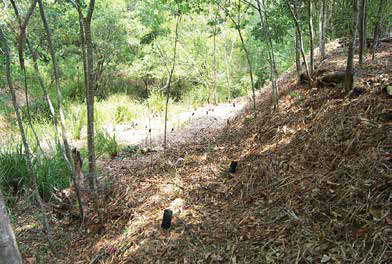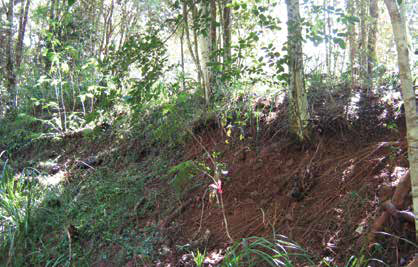Mosaic revegetation where only small areas of weeds are cleared and natives planted is proving to be effective.
The chequered history of our revegetation efforts is long and winding, and I would like to share some of the ways in which our experiences have completely changed our thinking and approach to revegetation over the years.
Our property in Upper Brookfield lies on Moggill Creek, with about 300 metres of creek frontage. When we moved here 22 years ago the creek was barely visible behind dense vegetation. Migrants from afar, we naively thought it all very exotic. In fact it was just the usual suspects: Lantana, Asparagus Vine, Glycine, Leucaena etc. The wildlife was abundant; water dragons, eels, yabbies, turtles and our resident Platypus.


Our misguided scorched-earth policy of weed removal (above) created the conditions for bank erosion (below) to occur when Moggill Creek flooded.
One day we received a flyer in our mailbox offering free plants for revegetation. Being from the Namib Desert, the concept of revegetation was somewhat new. Still plants for free must be worth investigating, especially since my husband is Scottish. So we made the call and received a visit from a local bush regenerator, who began our education on the art of revegetation.
Whilst I knew nothing about plants, I was won over by the idea that native vegetation would attract native fauna. We started our project as most novices do with enthusiasm and ignorance. Over the following months we cleared every visible weed (and probably some natives, too). Our scorched-earth policy left only the Chinese Elms that were too large for us to remove. An entire stretch of creek frontage was now cleared of vegetation, leaving a large bare patch ready for planting native species. With impeccable timing this coincided with the start of the El Nino and one of the worst droughts on record. Our attrition rate was well above 50% with the return of some drought resistant weeds taking care of the rest. The area was now severely degraded. When the rains came at last and Moggill Creek flexed its muscles, the remainder of our plants, and what little soil we had, was washed away.
Devastated, we thought this might be the end of our revegetation efforts. However the erosion risk was so bad that something had to be done. We realised that we need to radically alter our approach, so we decided to allow the whole area to revert back to its former weed-infested glory, in order to stabilise the creek bank. At the same time we began clearing small areas of about one metre between the weeds and planting natives.
This method was not the easiest as it was a slow and time-consuming process. We decided which weeds had to go (such as Madeira Vine and Freckle Face) and then removed them completely. Other weeds such as Asparagus Vine, Elephant Grass, Leucaena and Glycine we cut, leaving the roots in place to hold the bank and revisited them regularly to control their growth. We did this every month with a pair of garden shears, cutting them down to ground level and leaving the root system intact. The weed grasses we pruned high enough so they could bend over in the floods and protect the other plants. We were conscientious not to allow this area to become a weed source for properties downstream. We subsequently learned that this method of revegetation was called the ‘mosaic method’.
It has been four years since we adopted this approach and I am absolutely convinced of its efficacy. During the 2013 floods, our creek bank held for the first time and all of our plants survived. The native plants now outnumber the weeds and I believe it won’t be long before we will be weed free and lush with natives. There has been a gradual return of animals such as birds, water dragons and snakes along the creek and we are looking forward to welcoming back the Platypus!
Article and photos by Kate McVicar Land for Wildlife member Upper Brookfield, Brisbane
